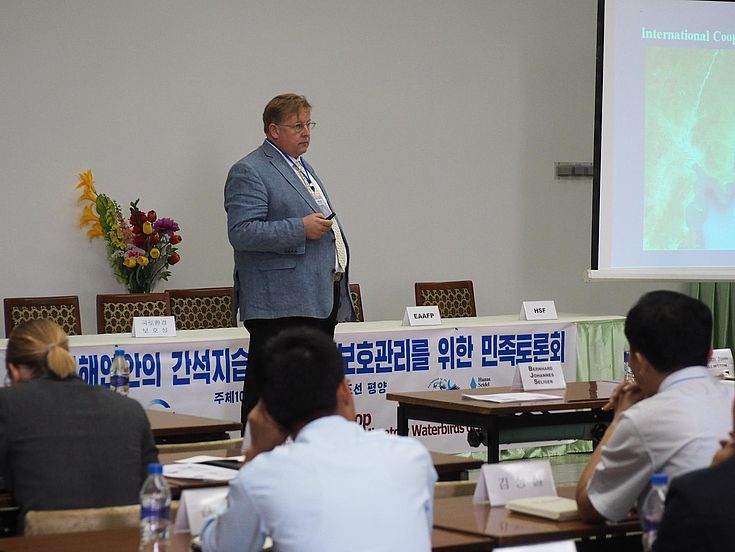National Workshop in Pyongyang on Conservation and Wise Use of Wetlands in North Korea
Dr. Bernhard Seliger, Resident Representative of HSF Korea, held a presentation about international cooperation with DPR Korea in the field of environment
The workshop was organized by the MoLEP and the International Union for the Conservation of Nature (IUCN) as well as Hanns Seidel Foundation and the East-Asian Australasian Flyway Partnership (EAAFP).
The tidal flats of the Yellow Sea or West Sea are a unique habitat supporting the overwhelming part of migratory water birds and shore birds. At the same time, reclamation in all adjacent country (China, South and North Korea) pose a threat to this unique habitat, resulting in huge decreases of numbers of water birds and shore birds, with some like the Spoonbilled Sandpiper likely facing extinction soon, if no measures are taken to preserve the remaining wetlands. Since development pressure in China and South Korea is particularly strong, North Korea becomes relatively more important as a resting place on the East Asian -
Australasian flyway. Preservation not only benefits biodiversity, but also is a basis for sustainable livelihood of fishery communities along the shore.
The workshop started with opening statements by Director-General Ri Kyong-Sim of MoLEP and Raphael Glement of IUCN. Both pointed out the importance to raise awareness for the importance of intertidal wetlands in the West Sea. The first sessions looked at the importance of international cooperation for the management and conservation of coastal wetlands. Raphael Glement discussed the tasks of cooperation from the point of view of IUCN, with particular reference to cooperation possibilities in the Yellow Sea area, which is one of the hotspots of work for IUCN. Spike Millington, Chief Executive of the EAAFP, in his presentation highlighted the importance of the Yellow Sea as a shared biodiversity resource of the adjacent countries. Dr. Bernhard Seliger of Hanns Seidel Foundation Korea reviewed the status of environmental cooperation between international partners and North Korea, pointing out the rapid development of ties since the launch of the program in 2015. Kim Jong-Chol of MoLEP looked at the status of migratory birds in the West Sea of North Korea.
The second session looked at national conservation measures and possibilities for listing of national sites as UNESCO world cultural heritage. Ho Myong-hyok of MoLEP explained wetland conservation and the drafting of Ramsar Information Sheets in DPRK (official name of North Korea). Spike Millington of the EAAFP again took the floor to look at the current efforts to list Yellow sea habitats as UNESCO world cultural heritage. In South Korea and China these efforts are progressing, North Korea as an indispensable part of the eco-region could also try to list sites in the future.
Finally, participants discussed in three groups the outcome of the workshop for their further work, identifying main threats and pressures on coastal wetlands and shorebirds and recommendations on management and Ramsar and World Heritage designations.
Hanns Seidel Foundation Korea since 2015 works together with IUCN, the EAAFP and other partners and the MoLEP to increase awareness of the challenge of wetland conservation and contribute to a national conservation strategy in North Korea. A number of important workshops have been held since then, leading to a successful membership application of MoLEP in IUCN. Membership in EAAFP and the Ramsar Convention on Wetlands are currently prepared.

